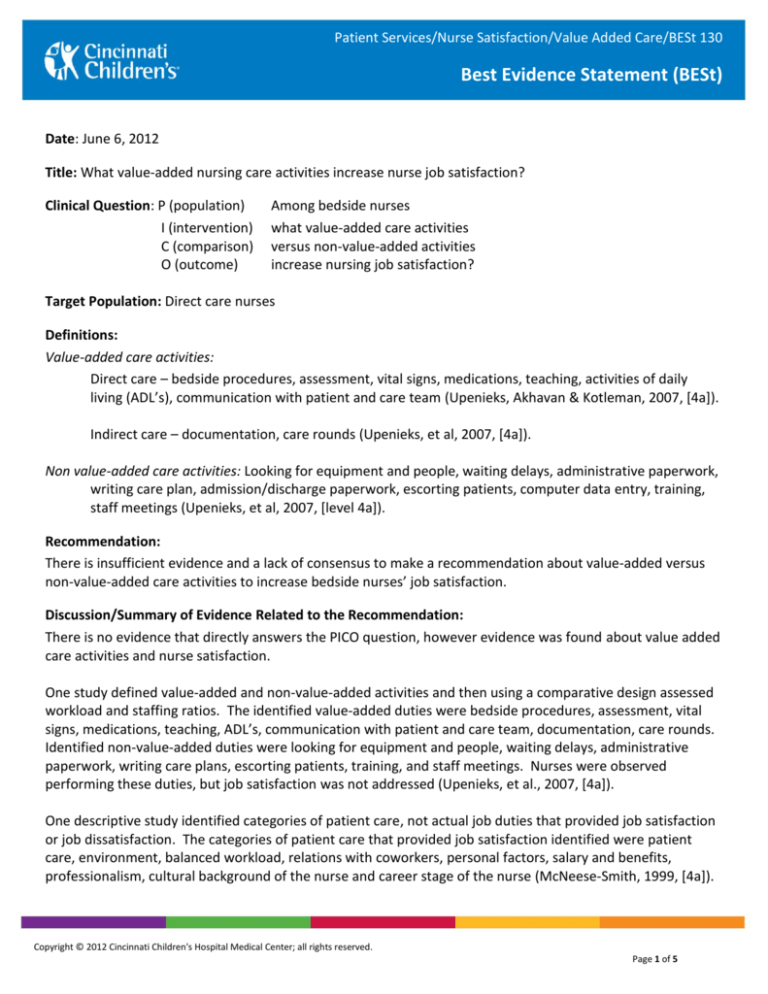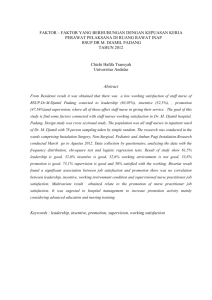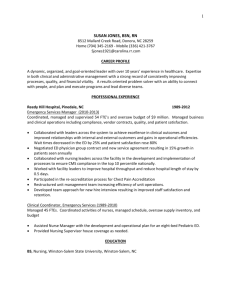
Patient Services/Nurse Satisfaction/Value Added Care/BESt 130
Best Evidence Statement (BESt)
Date: June 6, 2012
Title: What value-added nursing care activities increase nurse job satisfaction?
Clinical Question: P (population)
I (intervention)
C (comparison)
O (outcome)
Among bedside nurses
what value-added care activities
versus non-value-added activities
increase nursing job satisfaction?
Target Population: Direct care nurses
Definitions:
Value-added care activities:
Direct care – bedside procedures, assessment, vital signs, medications, teaching, activities of daily
living (ADL’s), communication with patient and care team (Upenieks, Akhavan & Kotleman, 2007, [4a]).
Indirect care – documentation, care rounds (Upenieks, et al, 2007, [4a]).
Non value-added care activities: Looking for equipment and people, waiting delays, administrative paperwork,
writing care plan, admission/discharge paperwork, escorting patients, computer data entry, training,
staff meetings (Upenieks, et al, 2007, [level 4a]).
Recommendation:
There is insufficient evidence and a lack of consensus to make a recommendation about value-added versus
non-value-added care activities to increase bedside nurses’ job satisfaction.
Discussion/Summary of Evidence Related to the Recommendation:
There is no evidence that directly answers the PICO question, however evidence was found about value added
care activities and nurse satisfaction.
One study defined value-added and non-value-added activities and then using a comparative design assessed
workload and staffing ratios. The identified value-added duties were bedside procedures, assessment, vital
signs, medications, teaching, ADL’s, communication with patient and care team, documentation, care rounds.
Identified non-value-added duties were looking for equipment and people, waiting delays, administrative
paperwork, writing care plans, escorting patients, training, and staff meetings. Nurses were observed
performing these duties, but job satisfaction was not addressed (Upenieks, et al., 2007, [4a]).
One descriptive study identified categories of patient care, not actual job duties that provided job satisfaction
or job dissatisfaction. The categories of patient care that provided job satisfaction identified were patient
care, environment, balanced workload, relations with coworkers, personal factors, salary and benefits,
professionalism, cultural background of the nurse and career stage of the nurse (McNeese-Smith, 1999, [4a]).
Copyright © 2012 Cincinnati Children's Hospital Medical Center; all rights reserved.
Page 1 of 5
Patient Services/Nurse Satisfaction/Value Added Care/BESt 130
A mixed methods study looked at eliminating non-value-added work. Key drivers of unnecessary work
associated with the day-to-day delivery of patient care were identified. The goal was to eliminate non-valueadded work and evaluate the impact of redesign on patient care. Work environment satisfaction was
measured by comparing 1999 and 2001 data. When compared with 1999 data (M = 52.1, SD = 3.7), 2001
employees reported higher satisfaction (M = 58.7, SD = 6.3, t (30) = 6.9, p < .0001). However, only four
employees completed work environment surveys before and after the redesign. The issue of job satisfaction
was not addressed (Capuano, Bokovoy, Halkins & Hitchings, 2004, [4b]).
A cross sectional quantitative study identified aspects of work life that provided satisfaction for nurses. Nine
aspects of work life were addressed that provided job satisfaction and seven aspects were addressed that did
not support nursing job satisfaction. This data could be considered value-added versus non-value-added
aspects of work life. However, these job aspects of work life were not actual job activities (Best & Thurston,
2004, [4b]).
Dimensions for Judging the Strength of the Recommendation:
Reflecting on your answers to the dimensions below and given that more answers to the left of the scales
indicates support for a stronger recommendation, complete one of the sentences above to judge the
strength of this recommendation.
(Note that for negative recommendations, the left/right logic may be reversed for one or more dimensions.)
1. Grade of the Body of Evidence
High
Moderate
Low
Comments:
2. Safety/Harm (Side Effects and Risks)
Minimal
Moderate
Serious
Comments:
3. Health benefit to patient
Comments:
4. Burden on patient to adhere to
recommendation
Comments:
5. Cost-effectiveness to healthcare system
Low
Costeffective
Comments: related to retention, productivity and efficiency.
6. Directness of the evidence for this target
Directly
population
relates
Comments:
7. Impact on morbidity/mortality or quality
High
of life
Comments:
Moderate
Minimal
Unable to
determine
High
Inconclusive
Not costeffective
Some concern of
directness
Indirectly
relates
Medium
Low
Reference List: (Evidence Level in [ ]; See Table of Evidence Levels following references)
Best, M. & Thurston, N. (2004). Measuring nurse job satisfaction. JONA 34(6), 283-290 [4b].
Capuano, T., Bokovoy, J., Halkins, D. & Hitchings, K. (2004). Work flow analysis eliminating non-value-added
work. JONA, 34(5), 246-256 [4b].
Copyright © 2012 Cincinnati Children's Hospital Medical Center; all rights reserved.
Page 2 of 5
Patient Services/Nurse Satisfaction/Value Added Care/BESt 130
McNeese-Smith, D.K. (1999). A content analysis of staff nurse descriptions of job satisfaction and
dissatisfaction. Journal of Advanced Nursing, 29(6), 1332-1341 [4a].
Upenicks, V., Akhavan, J. & Kotlerman, J. (2007). Value-added care: A new way of assessing nursing staffing
ratios and workload variability. JONA, 37(5), 243-252 [4a].
SUPPORTING INFORMATION
Background/Purpose of BESt Development:
One of Cincinnati Children’s Hospital Medical Center’s (CCHMC’s) hospital-wide strategic goals for 2015 is to
attain a 20% improvement in productivity through a combination of increasing/decreasing value added, nonvalue added and necessary work. Personal digital assistant software was purchased and a palm pilot study
was conducted on four units. Every nurse on the units carried a palm pilot for 3 weeks whenever they were
working. The palm pilot had nursing activities broken down into value-added versus non value-added
categories. The palm pilot would randomly signal the RN to enter the data requested on the screen. The
information was compiled by our outcomes manager and presented to department management. The
Transitional Care Center (TCC) was one of the four units chosen to develop a Value-Added Care initiative for
CCHMC. It was requested by the director of the TCC that evidence be explored regarding any previous studies
conducted on value versus non-value added activities and nurse satisfaction. The purpose of this BESt was to
compile the evidence found.
Applicability Issues: No evidence found relating to the question asked.
Outcome or Process Measures:
A nursing satisfaction questionnaire could be given to all unit staff nurses to measure satisfaction when
providing value-added care versus non-value-added care.
Search Strategy:
Databases: Medline/PubMed, CINAHL, hand search
Key words: direct patient care, nursing & satisfaction, value added care, non-value added care, bedside nurses
& job satisfaction, patient care, clinical nursing, work environment
Filters: English language
Dates searched: 1/01 to 12/11
Last search conducted: 12/1/11
Group/Team Members:
Team Leader/Author: Patricia Ashcraft, BSN, RN, CPN, Transitional Care Center
Support/Consultant: Barbara Giambra, MS, RN, CPNP, Center for Professional Excellence, Research and
Evidence-Based Practice
Ad Hoc/Content Reviewers: Kathleen Dressman, RN, MS, NEA-BC
Conflicts of interest were declared for each team member:
No financial conflicts of interest were found.
The following financial conflicts of interest were disclosed:
Copyright © 2012 Cincinnati Children's Hospital Medical Center; all rights reserved.
Page 3 of 5
Patient Services/Nurse Satisfaction/Value Added Care/BESt 130
Note: Full tables of evidence grading system available in separate document:
Table of Evidence Levels of Individual Studies by Domain, Study Design, & Quality (abbreviated table
below)
Grading a Body of Evidence to Answer a Clinical Question
Judging the Strength of a Recommendation (abbreviated table below, dimensions table above)
Table of Evidence Levels (see note above)
Quality
Definition
level
1a† or
Systematic review, meta-analysis, or meta-synthesis of
1b†
multiple studies
2a or 2b Best study design for domain
3a or 3b Fair study design for domain
4a or 4b Weak study design for domain
General review, expert opinion, case report,
5a or 5b
consensus report, or guideline
5
Local Consensus
†a = good quality study; b = lesser quality study
Table of Recommendation Strength (see note above)
Strength
Definition
It is strongly recommended
There is consensus that benefits clearly outweigh risks and burdens
that…
(or visa-versa for negative recommendations).
It is strongly recommended
that… not…
It is recommended that…
There is consensus that benefits are closely balanced with risks and
It is recommended that… not… burdens.
There is insufficient evidence and a lack of consensus to make a recommendation…
Copies of this Best Evidence Statement (BESt) and related tools (if applicable, e.g., screening tools, algorithms,
etc.) are available online and may be distributed by any organization for the global purpose of improving child
health outcomes.
Website address: http://www.cincinnatichildrens.org/svc/alpha/h/health-policy/best.htm
Examples of approved uses of the BESt include the following:
• copies may be provided to anyone involved in the organization’s process for developing and implementing
evidence based care;
• hyperlinks to the CCHMC website may be placed on the organization’s website;
• the BESt may be adopted or adapted for use within the organization, provided that CCHMC receives
appropriate attribution on all written or electronic documents; and
• copies may be provided to patients and the clinicians who manage their care.
Copyright © 2012 Cincinnati Children's Hospital Medical Center; all rights reserved.
Page 4 of 5
Patient Services/Nurse Satisfaction/Value Added Care/BESt 130
Notification of CCHMC at EBDMinfo@cchmc.org for any BESt adopted, adapted, implemented, or hyperlinked
by the organization is appreciated.
Please cite as: Cincinnati Children's Hospital Medical Center: Best Evidence Statement - What value-added
nursing care activities increase nurse job satisfaction?,http://www.cincinnatichildrens.org/svc/alpha/h/healthpolicy/best.htm, BESt 130, pages 1-5, June 6, 2012.
This Best Evidence Statement has been reviewed against quality criteria by 2 independent reviewers from the
CCHMC Evidence Collaboration.
For more information about CCHMC Best Evidence Statements and the development process, contact the
Evidence Collaboration at EBDMinfo@cchmc.org.
Note
This Best Evidence Statement addresses only key points of care for the target population; it is not intended
to be a comprehensive practice guideline. These recommendations result from review of literature and
practices current at the time of their formulation. This Best Evidence Statement does not preclude using
care modalities proven efficacious in studies published subsequent to the current revision of this document.
This document is not intended to impose standards of care preventing selective variances from the
recommendations to meet the specific and unique requirements of individual patients. Adherence to this
Statement is voluntary. The clinician in light of the individual circumstances presented by the patient must
make the ultimate judgment regarding the priority of any specific procedure.
Copyright © 2012 Cincinnati Children's Hospital Medical Center; all rights reserved.
Page 5 of 5






